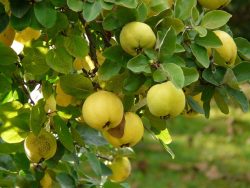Quince cultivation
4 October 2024
Quince cultivation
The quince bush is a beautiful and useful addition to the garden, which not only decorates it with its flowers but also provides fruit. To ensure healthy growth and good yields, it is important to pay attention to the right planting time and conditions. This article discusses the best practices for planting a quince bush and the basics of quince cultivation.
See international announcements on Agro-Market24: Quince purchasing
1. When to Plant Quince Bush?
The right time to plant a quince bush depends on several factors, such as climate and soil conditions. Here are the key points:
Spring or Autumn:
- The best time to plant a quince bush is in spring or autumn. Spring is ideal if you want the plant to settle before the summer heat. Planting in autumn allows the plant to prepare for winter and develop roots before spring growth begins.
Avoid Frost:
- If planting in spring, make sure all frosts have passed. If planting in autumn, do so a few weeks before the first frosts to allow the plant to settle in.
Soil and Conditions:
- Quince bushes prefer well-drained, moderately moist soil. Avoid areas where water stagnates, as excess moisture can lead to root diseases. The soil should be enriched with organic matter, such as compost, to nourish the plant.
2. Quince Cultivation in Poland
The quince tree (Cydonia oblonga) is a fruit plant that brings many benefits to the garden. Here are some tips:
Choosing a Variety:
- Choose a quince variety that suits your climate. In Poland, popular varieties include Bereczki, Japanese, and Vranja. They vary in their resistance to weather conditions and the flavor of the fruit.
Planting:
- When planting, dig a hole 40-50 cm deep and wide. Mix the soil with compost or well-composted manure. Place the plant in the hole, spreading out the roots, and cover it with soil. Make sure that the grafting point (if applicable) is above the soil surface.
Watering and Fertilizing:
- Quince bushes require regular watering, especially during dry periods. Fertilize the plant in early spring with organic or mineral fertilizers to support growth and fruiting.
Pruning:
- Pruning is essential for healthy growth of the quince bush. In spring, remove dead or damaged branches and those growing inward to improve air circulation and light access.
Protection Against Diseases:
- Quince bushes can be susceptible to fungal diseases, such as fire blight. Regularly monitor the plants and apply plant protection measures as needed.
Quince Bush – When to Plant?
If you want to grow quince as a bush, the rules are the same as for quince trees. Bushes should ideally be planted in early spring or late autumn in well-prepared soil. Remember to space the bushes properly to allow enough room for growth.
In summary, the right planting time and attention to the plant’s needs are key to healthy plants and good yields. Proper soil preparation, watering, fertilization, and pruning will ensure the best conditions for the growth and fruiting of the quince bush.
3. How to Cultivate Quince?
The quince (Cydonia oblonga) is a fruit plant that offers both beauty and fruit, which are used in cooking to make jams, compotes, or liqueurs. To have healthy plants and good yields, follow a few simple guidelines. Here is a guide to quince cultivation, from planting to care.
Quince cultivation is easy if you follow basic principles. Choosing the right variety, proper planting, regular fertilization and pruning, and protection against diseases will ensure healthy plants and good yields. Quince is a plant that will beautify your garden with its beautiful flowers and fruits and will also provide many culinary options.
Diseases and Pests
While cultivating quince, it is particularly important to monitor the plants for diseases and pests. Common quince can be susceptible to diseases such as brown rot of pome fruits, brown leaf spot, and fire blight. Powdery mildew is another disease that can attack growing shoots. Regular checks and the use of appropriate plant protection products will help maintain plant health.
Quince Fruits
Quince fruits are known for their hardness and tart flavor, which is why they are often used for preserves. Quince fruits are excellent for cooking, and their unique taste enhances many dishes. The fruits of the flowering quince, which is a close relative of the quince, can also be used in the kitchen, although they have a slightly different flavor profile.
Aesthetic and Utilitarian Qualities
Besides their utility, quince plants also have ornamental value. Large quince bushes or small trees can serve as a decorative element in the garden, especially during flowering. Their flower buds and fruits, which are often large and vibrant in color, add charm to any garden.
Properties of Quince
Quince fruits, including those from the large-fruited variety, are valued for their sour taste and unique properties. Quince fruits are ideal for various preserves, such as jams, compotes, liqueurs, or syrups. The pear quince, known for its large fruits, is also gaining recognition in the kitchen and garden.
To plant quince in your garden, it is best to choose young quince seedlings or quince seeds. Quince planting should take place in early spring or late autumn in well-prepared soil. The quince root system, which can be shallow, requires proper soil preparation enriched with compost and potassium fertilizers. Quince can also be propagated by layering, one-year shoots, or quince seeds. Growing shoots and essential branches should be regularly pruned to ensure healthy growth.
The common quince, like other fruit bushes, can be susceptible to various diseases and pests. The most common issues include brown rot of pome fruits, brown leaf spot, and fire blight. Powdery mildew is another disease that can attack growing shoots.
 Contact
Contact








